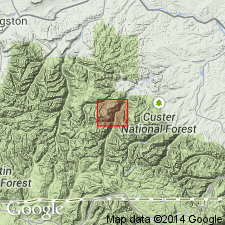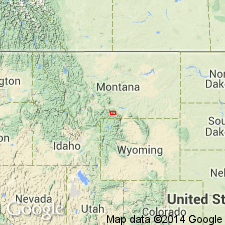
- Usage in publication:
-
- Mouat quartz monzonite
- Modifications:
-
- First used
- Dominant lithology:
-
- Quartz monzonite
- AAPG geologic province:
-
- Northern Rocky Mountain region
Summary:
First used [as an informal unit] for small pluton mapped about 1/2 mi southeast of Mouat chromite mine and just south of Nye PO, in northeastern part of Cathedral Peak area, Stillwater Co, MT (Northern Rocky Mountain region). Type locality not designated. Derivation of name not stated; presumed to be named from Mouat chromite mine. Is coarse-grained and is different in appearance from granitic gneiss (mapped nearby, pl. 1), lacking foliation or compositional layering; Carlsbad-twinned microcline is conspicuous. Pluton is intrusive into hornfels near base of Stillwater complex, and hornfels xenoliths common near contacts of pluton. Consists of microcline, oligoclase, biotite, and quartz, with an average grain size of about 2 mm. Texture is xenomorphic-granular, and is not markedly inequigranular like the granitic gneiss. Quartz does not have undulatory extinction and suture contacts, typical of granitic gneiss. Microcline is a vein or string perthite, with myrmekite common around the edges of grains. Chemical composition given (table 1). Pluton may have been emplaced in the aureole while temperatures were still relatively high, before Stillwater complex had completely cooled. Pluton may represent an anatectic melt formed during contact metamorphism. Has zircons at least 3,100 m.y. old that suffered severe lead loss in a 2,750 m.y. event.
Source: GNU records (USGS DDS-6; Denver GNULEX).

- Usage in publication:
-
- Mouat quartz monzonite
- Modifications:
-
- Age modified
- Geochronologic dating
- AAPG geologic province:
-
- Northern Rocky Mountain region
Summary:
Two samples (J14-4 and J24-5) of Mouat quartz monzonite are from localities south of the Stillwater complex near its southeast end, Stillwater Co, MT (Northern Rocky Mountain region). Both are definitely geologically younger than the Stillwater complex, but contain zircons that are (within analytical error) the same age as the Stillwater complex. U-Pb dating of zircons from the two samples yields an age of 2,750 m.y. Pb207/Pb206 data from apatite in sample J14-4 suggests the apatite episodically gained uranium or lost lead about 1,600 m.y. ago during an event that did not significantly influence the zircon ages.
Source: GNU records (USGS DDS-6; Denver GNULEX).
For more information, please contact Nancy Stamm, Geologic Names Committee Secretary.
Asterisk (*) indicates published by U.S. Geological Survey authors.
"No current usage" (†) implies that a name has been abandoned or has fallen into disuse. Former usage and, if known, replacement name given in parentheses ( ).
Slash (/) indicates name conflicts with nomenclatural guidelines (CSN, 1933; ACSN, 1961, 1970; NACSN, 1983, 2005, 2021). May be explained within brackets ([ ]).

